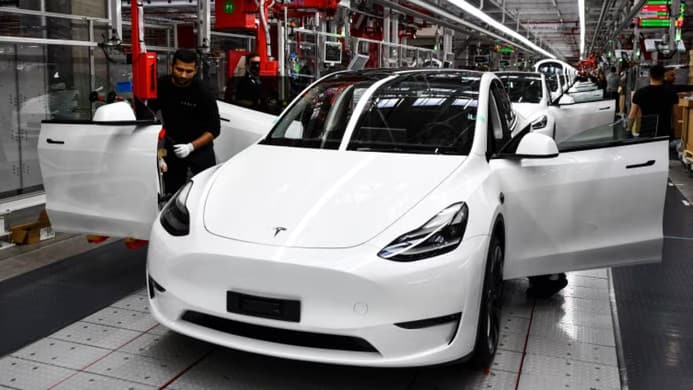This article was originally published on Fool.com. All figures quoted in US dollars unless otherwise stated.
Tesla (NASDAQ: TSLA) stock is down 7.2% on Thursday as of 9:52 a.m. ET, following the electric vehicle pioneer's release of its third-quarter report yesterday.
The stock's drop is probably largely attributable to the quarter's revenue coming in a little lighter than Wall Street's consensus estimate. Given the challenging market conditions in 2022, many investors are reacting more unfavorably to even relatively minor blips in quarterly earnings reports than they did when the market was in a bull mode.
There was much to like about the report. Adjusted earnings per share (EPS) beat the analyst expectation, and revenue, operating profit, and free cash flow set quarterly records.
The following is an overview of Tesla's third quarter centered on seven key metrics.
1. Revenue surged 56%
Quarterly revenue grew 56% year over year to $21.45 billion. This result fell short of the $21.96 billion Wall Street consensus estimate.
Revenue growth was primarily driven by increased vehicle deliveries and a higher vehicle average selling price, partially offset by the strengthening of the US dollar relative to other currencies. Tesla's clean energy and services/other businesses also contributed to growth.
Segment year-over-year revenue performance was as follows:
- Automotive segment revenue grew 55% to $18.7 billion.
- Energy generation and storage revenue rose 39% to $1.1 billion. Growth was driven by a 66% increase in energy storage capacity deployments to a record 2.1 gigawatt hours (GWh) and a 13% increase in solar power deployments to 94 megawatts (MW).
- Services and other revenue rose 74% to $1.6 billion. Growth was driven by used car and part sales along with a more than threefold increase in paid use of Superchargers.
2. Vehicle production and deliveries grew 54% and 42%, respectively
In Q3, Tesla produced 365,923 vehicles (about 20,000 Model S and X units and 346,000 Model 3 and Y units), up 54% from the year-ago period.
And it delivered 343,830 vehicles (about 19,000 Model S/X and 325,000 Model 3/Y), up 42% year over year.
3. Auto gross margin was 27.9%
In Q3, automotive gross margin (gross profit divided by revenue) based on generally accepted accounting principles (GAAP) was 27.9%. While this is a strong auto gross margin, it was down from 30.5% in the year-ago period. Sequentially, it was flat, as it was also 27.9% in the second quarter.
4. Operating income rocketed 84%
In Q3, operating income grew 84% year over year to $3.7 billion. Operating margin (operating income divided by revenue) landed at 17.2%, up from 14.6% in the year-ago period.
5. Adjusted EPS soared 69%
GAAP net income was $3.3 billion, or $0.95 per share, up 98% from the year-ago period. Adjusted for one-time items, net income came in at $3.7 billion, or $1.05 per share, up 69% year over year. This result surpassed the $1 adjusted earnings per share (EPS) that analysts had expected.
6. Operating cash flow jumped 62%
In Q3, cash generated from operations grew 62% year over year to $5.1 billion. Free cash flow skyrocketed 148% to $3.3 billion.
Tesla ended the quarter with $21.1 billion in cash, cash equivalents, and short-term investments, up by $2.2 billion from the prior quarter.
7. Supercharger stations increased 32%
Tesla continued its solid pace of building out its network of Supercharger stations. It ended the quarter with 4,283 stations, up 32% from the year-ago period. Supercharger connectors grew 33% year over year to 38,883.
A great quarter with a new revenue source coming soon
Tesla turned in a great quarter. The company recently began production of its all-electric Class 8 truck, the Tesla Semi, at its Gigafactory in Nevada. It plans to begin deliveries to PepsiCo in December. The beverage and food giant reportedly reserved 100 of these trucks soon after Tesla unveiled this vehicle in 2017.
This article was originally published on Fool.com. All figures quoted in US dollars unless otherwise stated.









